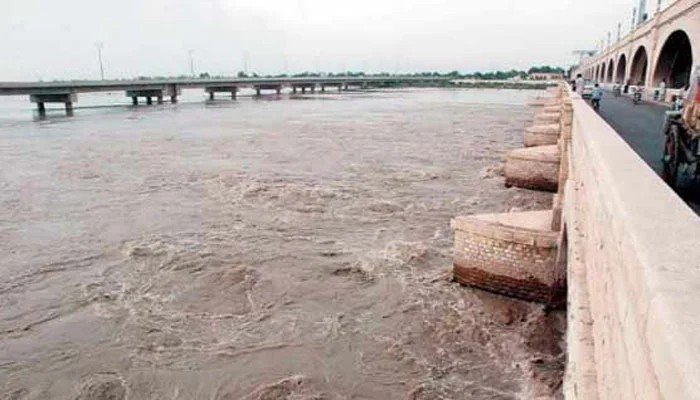
As monsoon rains continue to lash various parts of Pakistan and rising temperatures accelerate the melting of glaciers in the northern regions, the threat of severe flooding looms large over several provinces. The National Disaster Management Authority (NDMA) and local meteorological departments have issued warnings about possible flash floods and glacial lake outburst floods (GLOFs), particularly in the mountainous regions of Gilgit-Baltistan and northern Khyber Pakhtunkhwa.
According to meteorological reports, a combination of persistent heavy rainfall and an unusual rise in temperature has led to a surge in water levels in the country’s major rivers, including the Indus and its tributaries. These rivers are primarily fed by glacial meltwater from the Himalayas, Karakoram, and Hindu Kush mountain ranges—areas currently experiencing accelerated glacial melting due to climate change and regional heatwaves.
Rising River Flows Raising Alarm
Officials from the Pakistan Meteorological Department (PMD) confirmed that the water levels in the Indus River and its northern tributaries have risen significantly over the past week. In Gilgit-Baltistan, remote valleys like Ghizer, Hunza, and Skardu have reported fast-moving streams and rivers nearing danger levels. Similar concerns have emerged from the Swat, Chitral, and Dir regions of Khyber Pakhtunkhwa.
“This is a dangerous mix—increased glacial melt and ongoing rains are combining to create extremely high flow rates in rivers and streams,” said an official from NDMA. “We’re closely monitoring the situation with provincial disaster management authorities and advising early evacuation in high-risk zones.”
Glacial Lake Outburst Floods (GLOFs): A Growing Threat
In recent years, the number of glacial lakes in northern Pakistan has increased dramatically, particularly in Gilgit-Baltistan and Chitral, due to rapid glacial melting. These lakes are often dammed by unstable ice or loose debris, and when the pressure becomes too great—typically during intense rainfall or high temperatures—the natural dam can burst, sending torrents of water downstream without warning.
In the last week, authorities have reported signs of instability in several glacial lakes. “We’ve issued alerts for potential GLOF events in at least six valleys,” said a spokesperson for the Gilgit-Baltistan Disaster Management Authority. “Community-based disaster response teams are on standby, and temporary shelters have been established.”
Evacuation and Preparedness Efforts Underway
The NDMA, in collaboration with local authorities, has begun preemptive evacuation measures in highly vulnerable areas. Emergency shelters are being set up in safer locations, and rescue teams are being deployed in remote districts with a history of flood-related disasters.
In Swat and Chitral, several families have already been moved to higher ground following reports of rising water in nearby rivers. Meanwhile, local authorities in Gilgit-Baltistan have suspended trekking permits and advised tourists to avoid risky regions.
“Our priority is to prevent loss of life,” said a senior NDMA official. “Infrastructure can be rebuilt, but we need to ensure people are out of harm’s way before these rivers breach their banks.”
Climate Change at the Core
Experts are pointing once again to the increasing impact of climate change on Pakistan’s fragile ecosystems. Pakistan is home to more glaciers than any other country outside the polar regions, but they are melting at an alarming pace.
“Extreme weather events are becoming more frequent and intense,” said Dr. Shahana Ahmed, a climate scientist based in Islamabad. “Not only are monsoon rains arriving in irregular patterns, but glacial melt is now occurring far earlier in the season and in greater volumes.”
She emphasized that these are not isolated weather events but rather signs of a larger, climate-driven transformation affecting the entire region. “What we’re witnessing is the result of global warming. Without mitigation efforts, the risks will only increase.”
Public Advisory and Safety Measures
The NDMA and PMD have advised the public to remain alert, especially those living near riverbanks or in flood-prone valleys. Citizens are being urged to:
-
Monitor official weather updates and flood alerts regularly.
-
Avoid unnecessary travel to northern areas until conditions stabilize.
-
Cooperate with evacuation efforts and follow safety instructions from local authorities.
-
Prepare emergency kits and stock up on essential supplies in case of displacement.
Conclusion
Pakistan faces a critical moment as the dual threat of monsoon rains and glacial melting pushes its river systems to their limits. While authorities are making every effort to manage the risk, the scale of the challenge highlights the urgent need for long-term climate resilience planning.
As floodwaters rise, so does the need for preparedness—not just by governments, but also by communities and individuals who live in the shadow of these increasingly volatile mountains.
Reference: بارشوں اور گلیشئر پگھلنے سے دریاؤں میں پانی کا بہاؤ بڑھ گیا،سیلاب کا خطرہ منڈلانے لگا

